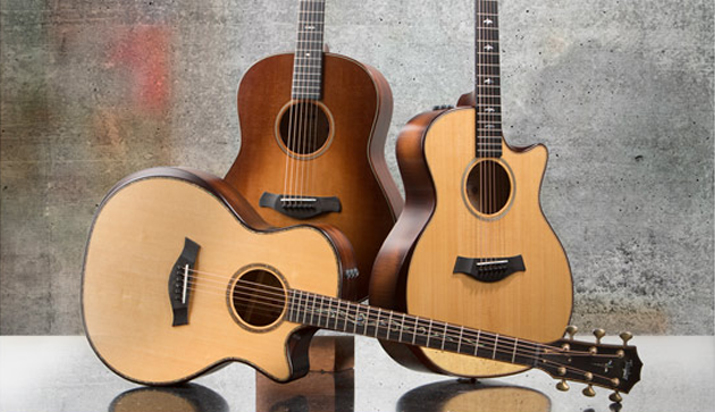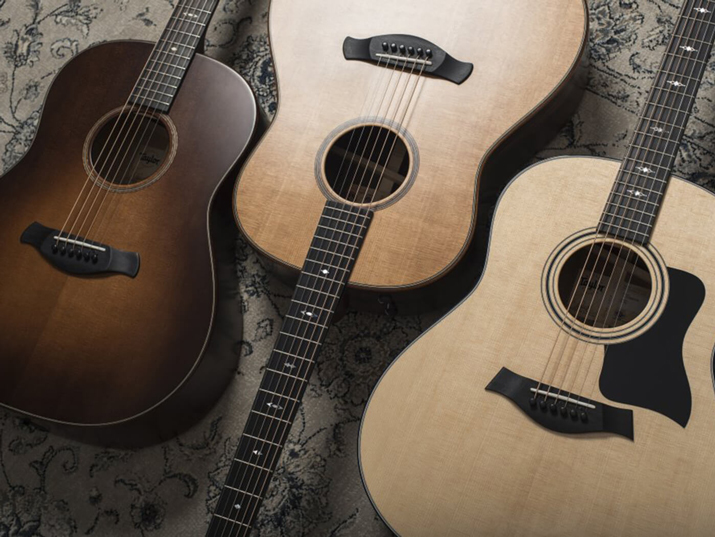Taylor release a new body shape - The Grand Pacific
Posted on Mon 04 February 2019 in namm-2019
Taylor are known to be the Ying to Martin’s Yang. A modern sounding instrument manufacturer making guitars with a powerful clear voice, a voice where each note is clear and concise. They are relatively young within the industry as a whole but this clear, concise nature to their sound has obviously been applied to their business practices and resonated among the guitar buying public as they find themselves sitting at the top of the pile as one of the most respected instrument manufacturers trading today.
Martin on the other hand are steeped in tradition and during the 20th century they ushered in the most popular acoustic guitar design that has ever been: the dreadnaught.
So iconic is the shape, it’s silhouette is conjured in your minds eye when you think ‘acoustic guitar’. It is a design that set out to do one thing, one thing that was needed well before the dawn of electric amplification, that one one thing that many of us today still feel to be one of the most fundamental attributes to acoustic instruments. Volume.
Although the design was introduced earlier in the century it never found it’s place within the market. By the time the 1930s rolled around the number one genre was Bluegrass. Bluegrass music is dominated by rather noisy banjos and the smaller guitars of old found their voices drowned out by these more efficient noise makers. Martin reintroduced the dreadnaught guitar to great acclaim and has been making them ever since.
Although incredibly popular among Folk and Bluegrass players, they have made their way into every conceivable acoustic guitar genre there is.
Why is this design so enduring? Well apart from the volume to be heard in a crowd they also sounded great. Particular models from the 1940s have been known to fetch tens of thousands of dollars.
All this popularity doesn’t mean it’s a perfect design. They need to be played hard, can be sometimes be somewhat overpowering in the low end and lack a certain finesse that smaller bodied guitar capture so well. Even though these shortcomings are well documented they do not deter nearly every guitar maker to issue their own version of this fabled guitar.
Taylor have had their own version of the dreadnaught kicking around in their range for a years now but the time has come for the new captain at the helm, Andy Powers to take this tried and true classic and reinvent it for the 21st Century. This reinvention has come in the form the new Grand Pacific body shape; the first new body shape to be introduced by Taylor in many years. Introduced at NAMM 2019 the Grand Pacific is set to build upon the original shapes strengths but also remedy it’s shortcomings. Powers himself says that Taylor’s voice is probably best described as a triangle, very defined and pointed, whereas guitars from the ‘golden era’ tend to have a softer edge to their tone. This warmer voice is an intrinsic part of the sound of American Folk music. Taylor know that they create brighter, lively instruments that don’t necessarily fit this particular style as well as something Martin may produce but hope to fill that void in their offerings with the Grand Pacific.
A slightly edited silhouette but still recognisably a dreadnaught it isn’t breaking the traditional mould too much. Under that soundboard on the other hand things take a slightly more modern approach. Taylor introduced their new V-Class bracing pattern to great acclaim last year, this new design goes a long way to improving certain undesirable acoustic characteristics (more details can be found about this here). By employing this new design and fusing it together with the usual traditional building appointments they have created a dreadnaught that, on the whole behaves itself a little more, this makes for a more reliable and consistent instrument when recording, performing or just when writing; it’s has more composure you could say.
The low end has been toned down slightly so that you don’t get an overpowering bass that drowns out the higher notes but without loosing that depth the shape is known for, the pointed edges of the notes have been rolled off to give a familiar but new voice that places itself well and truly in the sonic landscape of yesteryear.
All around these guitars look to be quite a big step in the right direction for the company and also showing that Andy Powers has one eye on the future and the other keenly focused on acoustic guitar tradition. Upon hearing and seeing these instruments I feel it has the ability reignited interest in the classic dreadnaught.
They enter three of Taylor’s ranges, these being:
300 Series - Sapele/Spruce
500 Series - Mahogany/Torrefied Spruce
700 Series - Rosewood/Torrefied Spruce
Each come in natural and Wild Honey Burst (think faded Gibson J45 burst and you’re on the right track). There is sure to be a combination of woods and finish that suits anyone in the market for a new, but traditional acoustic guitar. Pair this with Taylor’s reputation for quality, innovation and tone this new range is sure to win over the hearts the many.


